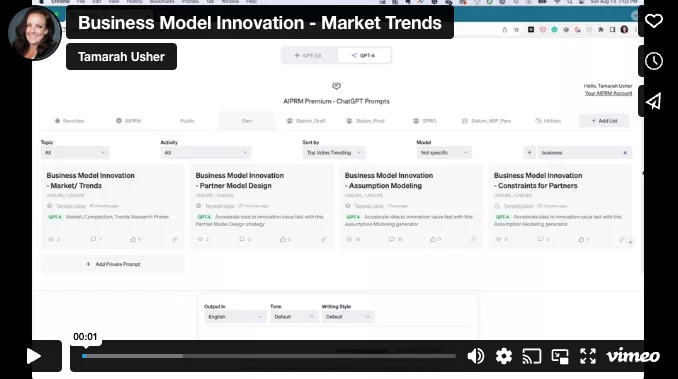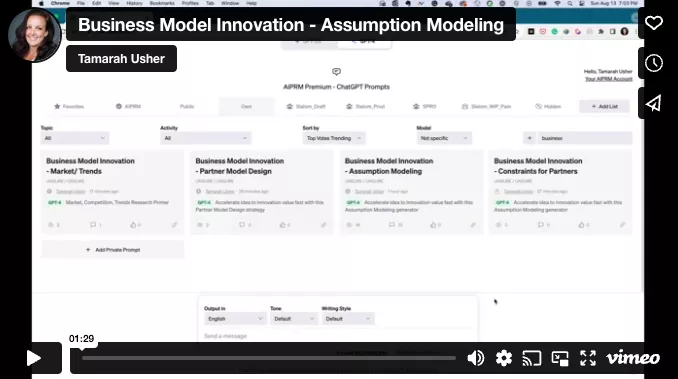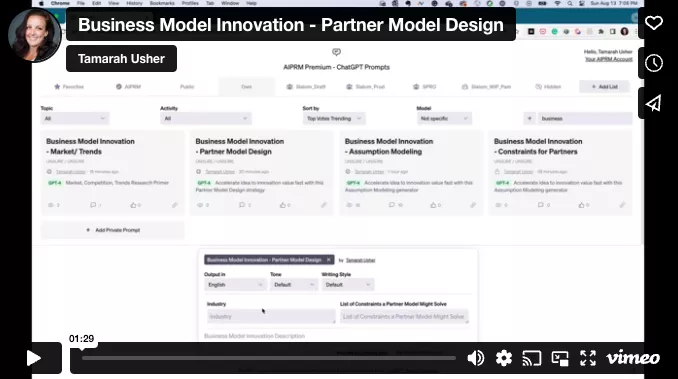Accelerating business model innovation with Gen AI

Revolutionizing innovation and augmenting human capabilities
Innovation has always been the cornerstone of real progress in business. As industries become increasingly competitive and fast-paced, organizations seek ways to improve their innovation pipeline, value, and speed to market. Generative artificial intelligence (GenAI) has emerged as a powerful tool in this pursuit, revolutionizing how companies can approach market research, ideation, problem-solving, and product launches. In this blog post, we will explore the transformative potential of generative AI across Slalom’s stages of the innovation journey, from idea generation to market fit and beyond.
GenAI is especially helpful at several specific times along the innovation journey. It is exceptionally adept at augmenting customer feedback and extrapolating market trends. It can identify patterns and make predictions by analyzing vast amounts of data, providing valuable insights for strategic decision-making. In doing so, GenAI accelerates the speed to market and speed to value by reducing processes that might have taken months to days or even hours.
However, there are areas where GenAI is best used in conjunction with human interaction. For instance, it is not a real customer and can’t replace human feedback or insights gained from direct interactions. While it can provide valuable data-driven feedback, it lacks the nuanced understanding from firsthand customer experiences. Additionally, evaluating a solution’s fit within a specific company’s unique portfolio and strategy requires a human touch. AI alone can’t fully grasp each organization’s culture, resources, and goals.
And with the current acceleration of GenAI being fueled by several factors, booms and busts in GenAI startups have become more frequent, with some companies solving problems so rapidly that they negate their own startup value within a year. The cycles in the AI industry are becoming quicker, demanding that almost all companies invest in continuous adaptation and innovation. However, it’s essential to remember that GenAI should augment and accelerate human capabilities, not replace them.
Slalom’s test-and-learn pathways, from insight to innovation
At Slalom, our Innovation Pipeline Activation embodies our dedication to foresight and systematic research. Designed for a dynamic business landscape, our approach proactively anticipates and mitigates risks. More than just stages, our pipeline reflects our commitment to agile and open innovation. With a foundation in rigorous experimentation, our test-and-learn methodology ensures adaptability in every strategy. Looking into the future, generative AI supercharges our innovative capabilities, redefining the blueprint of business model innovation.
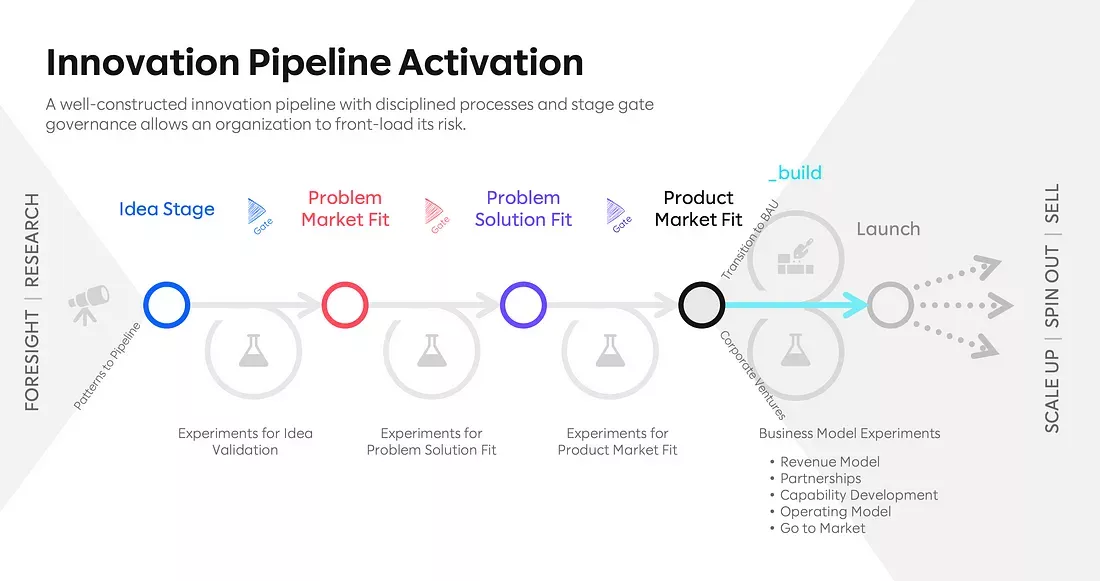
A “show, don’t tell” approach to generative AI
At Slalom, we go beyond merely discussing the transformative power of GenAI; we’re keen on showcasing its tangible impact. Using our approach, we’ll guide you through the myriad applications of GenAI across various stages of business model innovation. Among the options presented, we’ve highlighted and brought to life a few key areas: from market exploration and assumption modeling to design prototyping and partner strategy design. Witness firsthand how GenAI seamlessly integrates, enhancing each step. Through this illustrative journey, we move beyond theoretical concepts, underscoring our commitment to practical, transformative GenAI applications that are actively reshaping the innovation landscape.
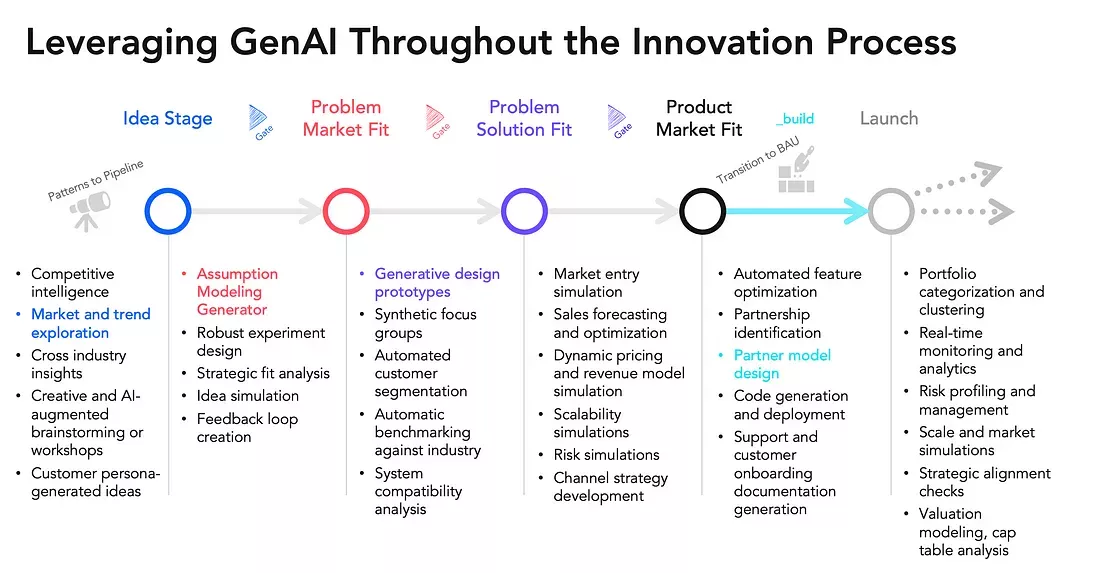
Market research and the unleashed power of data
Market research stands as the bedrock for trailblazing innovation in our methodology. Drawing from vast pools of data, spanning diverse sources and often proprietary internal datasets, we unearth pivotal insights into customer behavior, market shifts, and nascent opportunities. Through rigorous analysis, we enable organizations to pinpoint gaps in their current offerings and recognize untapped potential, equipping them to make judicious decisions and embark on strategic business model innovation initiatives.
Demo: Market and trend exploration with GenAI
The demo delves deep into the details of industry-specific markets and trends using AIPRM, a Chrome plug-in for ChatGPT that provides users with custom-curated prompts. For those eager to experience Slalom’s AIPRM prompt firsthand, we’ve provided a link for you here. This isn’t just a glimpse into the future of market and trend exploration — it’s our gift to you. Dive in, explore, and witness the power of GenAI for this crucial strategic step for yourselves.
Assumption modeling and the quest for overturning uncertainty
At the heart of our approach lies the Business Model Canvas, a strategic tool that meticulously maps out vital business model components, from unique value propositions to key customer segments. But a canvas, no matter how detailed, remains a static representation unless it’s put to the test. This is where our assumption modeling steps in. Central to our methodology, we constantly challenge and validate each canvas element, driving clarity and innovation. Whether it’s gauging the intricacies of “customer behaviors” or reenvisioning channels of value delivery, our assumption modeling provides a systematic, iterative process to refine each section. In our hands, the canvas isn’t just a static blueprint; it’s a dynamic landscape where business hypotheses are continuously explored, validated, and evolved.
Demo: Business model assumptions for testing
The demo delves deep into the intricacies of assumption modeling by business model components using AIPRM, a Chrome plug-in for ChatGPT that provides users with custom-curated prompts. For enthusiasts wanting a hands-on experience, we’re offering direct access to the prompt. Beyond being a mere window into advanced assumption modeling, this is an invitation from us. Engage, investigate, and personally grasp the significance of this critical innovation phase.
Design prototypes convey the boundless potential of the future
Delving deeper into our innovative approach, we encounter the pivotal role of design prototypes. These tangible representations of future visions are not merely illustrative but interactive explorations of what’s to come. Our approach to designing prototypes transcends mere visualization — it’s about tangible interaction and iterative refinement. At every stage, we emphasize functionality, user experience, and adaptability. While many see prototypes as the end product of a design process, we view them as living entities, evolving with each feedback loop and insight gathered. Through our method, design prototypes don’t just predict the future; they actively shape it, ensuring that the final product isn’t just functional, visionary, and innovative.
Demo: Generative design prototypes
Partnership strategy for joint business model activation
In most modern strategies, collaboration is crucial. Understanding the power of collective effort, we emphasize partnership synergy. Instead of working on business models separately, our approach promotes co-creation, pooling strengths, and tackling challenges together. This method allows us to combine resources and insights, breaking conventional limits. Partnerships are more than simple alliances; they’re about joining forces to innovate effectively and produce robust, forward-thinking business models.
Demo: Partner model strategy design
The demo delves deep into the intricacies of partner model strategies, again using AIPRM, a Chrome plug-in for ChatGPT that provides users with custom-curated prompts. Those with a zest for exploring new frontiers can delve directly through our provided prompt link. Rather than just showcasing the depth of partner strategy design, this is our call to action for you. Dive deep, understand, and truly appreciate the essence of this strategic unlock.
Partnership strategy for joint business model activation
In most modern strategies, collaboration is crucial. Understanding the power of collective effort, we emphasize partnership synergy. Instead of working on business models separately, our approach promotes co-creation, pooling strengths, and tackling challenges together. This method allows us to combine resources and insights, breaking conventional limits. Partnerships are more than simple alliances; they’re about joining forces to innovate effectively and produce robust, forward-thinking business models.
This blog post was originally published here.
